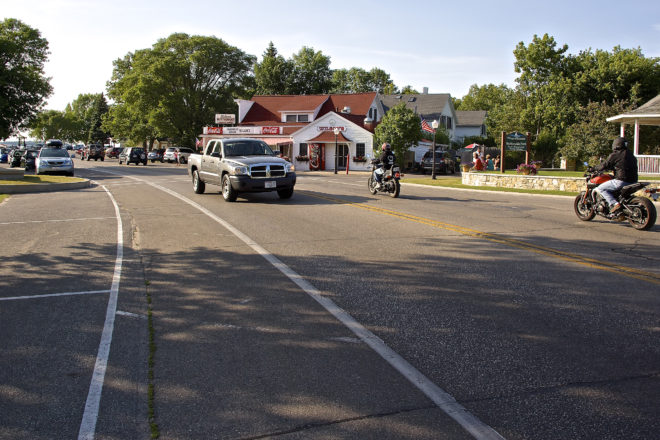Ephraim Trustees Embattled Over Sidewalks, Pedestrian Safety
- Share
- Tweet
- Pin
- Share

Tensions are rising between Ephraim village trustees as the deadline for the village to submit changes to the upcoming highway resurface plan looms. Trustees clashed over the cost, moral responsibility and legal liability of constructing sidewalks along the highway.
Last week the village met with the Department of Transportation (DOT) to settle on a Nov. 1 deadline for the village’s portion of the highway resurface plans.
Village Board President Mike McCutcheon claimed DOT Project Manager Jeremy Ashauer gave him a verbal commitment to the three-month extension earlier this year, which was shortened to six-weeks, or Sept. 15, in writing. After a meeting on June 23, village officials and the DOT settled on a Nov. 1 deadline.
“It’s on the understanding that they [the village] understand that’s really a hard date and we don’t have any flexibility with that date,” said Ashauer. “There’s been a bit of miscommunication lately but we had a meeting on Friday (June 23) and we talked about where things are going… I think it’s just a matter of making sure everybody is on the same page.”
Some village officials expressed frustration with the changing deadlines and showed general distrust of the DOT.
“Jeremy sitting in that room, he can sit and talk all he wants,” said Tim Nelson. “He can tell you three months, he can tell you six months, he can tell you five years, it doesn’t matter.”
The DOT will contribute an estimated $245,000 toward the resurfacing. The DOT funds are based on the costs for similar projects the DOT has completed in Door County, such as the 2014 resurface between Sturgeon Bay and Egg Harbor.
“One of the things that is coming together here after a long time is the actual cost,” said McCutcheon, adding that burial of the power lines would cost $1.2 million.
The DOT will pay for the basic resurfacing of the highway between the wetlands on the south end of the village to Anderson Dock on the north side, even if those costs exceed the estimated $245,000. Any additional costs for infrastructure such as storm water management, sidewalks and curbs would be paid by the village.
Discussion on sidewalks descended into morality versus liability involving pedestrian safety and possible costs for a village of less than 300 residents.
“The entire road from the grass on the west side to the grass on the east side belongs to the State of Wisconsin,” said Paul Roppuld, village trustee. “It is not our responsibility and therefore the safety of pedestrians on that road is also not our responsibility and I don’t see any reason to assume that level of liability.”
“As human beings, safety of other people is always our responsibility,” said Cindy Nelson, village trustee. “I’m not talking about lawsuits, I’m simply talking about being a human being and watching out for each other. So safety is our responsibility in my opinion.”
“I do not believe that just because the state owns the road it absolves us of a moral responsibility to try to make it as safe as possible,” said McCutcheon. “We cannot buy that it’s the state’s property and we have no responsibility or that we would be held liable for it. I can’t buy that.”
“I guess some of our board members don’t give a damn if somebody gets hurt but we all should be worried about it,” said Jim Stollenwerk, village trustee. “It’s absolutely a dangerous situation out there particularly at night… I think we have to have some fiscal responsibility but we sure as heck should do something.”
Trustee Tim Nelson said walking along the highway is not particularly safe, but expressed concern with the way curb, gutter and sidewalks could affect encroachment on properties and cutting of trees adjacent to the highway.
The village’s hired engineers at AECOM estimate that sidewalks would cost $154,170. AECOM also estimated the highway resurface would cost around $700,000, significantly higher than the DOT’s estimated $245,000 cost.
The village is planning a meeting with engineers at AECOM and DOT officials for the first half of July to negotiate possible exceptions to DOT’s standards such as lane width. If the village chooses not to produce a plan for storm water management, curbs and sidewalks or doesn’t do so by Nov. 1, then the DOT will resurface the road just as it is now.
Legal Liability on State Highways
Let’s set aside the moral argument for pedestrian safety and providing sidewalks along a state highway through a downtown district to talk about legal liability.
Ephraim Village Trustee Paul Roppuld is opposed to constructing sidewalks along Hwy. 42 in Ephraim, citing the possible liability the village would take on. He believes pedestrian safety along a state highway is the responsibility of the state, not the village. Legally, he is probably right.
“It is ultimately the property owner’s responsibility,” said Daniel Olson, assistant legal counsel for the League of Wisconsin Municipalities. “In this case that would be the State of Wisconsin and not the village.”
The most active body of case law on this topic surrounds determining responsibility when someone slips and falls on a sidewalk in the winter.
The overwhelming majority of lawsuits involving falling on the sidewalk determine that whoever owns the sidewalk is liable for the damages due to negligence. Sidewalks along local roads are generally owned by the local municipality.
This has caused many municipalities to pass ordinances requiring a property owner to keep the sidewalk in front of their lot clear from snow and ice. Still, that doesn’t clear the municipality of blame. If a property owner doesn’t clear the sidewalk, the municipality is still at fault if anyone slips and falls.
The DOT contracts with local county governments for snow removal on state highways and the interstate system, absolving the DOT of liability. They have a similar agreement on the removal of dead deer from the road, which is handled by the Department of Natural Resources or local governments.
Without one of these agreements, the state is responsible for everything within the state highway’s right of way.
“It’s their property and unless there is some form of agreement between the village and the state whereby the village assumes liability or accepts liability for the maintenance of that area, there wouldn’t be any,” said Olson.
However, the Pulse requested the State Bar of Wisconsin perform a search for any lawsuits involving the DOT’s liability in pedestrian safety and the search came up with nothing. There is no case law saying the DOT is responsible for providing safe pedestrian walkways along state highways, even if the property is owned by the state.

